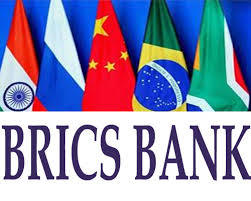Capital to Double in Couple of Years

Being pitched as alternative to existing institutions such as the World Bank and the International Monetary Fund, five of the largest emerging economies of the world together gave shape to and opened a global bank on July 21. The bank has been christened the New Development Bank (NDB).
The bank is also known as the BRICS bank and is funded by the countries of Brazil, Russia, India, China and South Africa. The primary objective of the bank is to finance infrastructure and development projects in BRICS countries.
Proposal for the bank was made in 2012. The launch of the bank was delayed due to disagreements over the bank's funding, management and headquarters.
With an estimated capital of US $100 billion, the BRICS bank is representative of 40 per cent of the world's population. It is noteworthy that China, a part of the BRICS association, is also part of a conglomerate that plans to set up another new multilateral lender, the Asian Infrastructure Development Bank (AIIB).
Kundapur Vaman Kamath, the president of NDB said that the objective the bank was to improve and complement the system by its own polices rather than to challenge the existing system as is being perceived.
“After a meeting with the AIIB in Beijing, the NDB had decided to set up a hotline with the AIIB to discuss issues and to forge closer ties between new institutions coming together with a completely different approach” said Kamath.
The bank plans to raise funds by issuing large number of bonds in the member markets to help mitigate costs arising from exchange rate fluctuations.
The long running bottlenecks for infrastructure projects would be cleared with help of funding from the new bank, said the Chinese Finance Minister Lou Jiwei. He said that the projects in these countries that have hit a road block due to funds crunch would be speed up, adjust and upgrade.
Other global and regional banks have welcomed the setting up of NDB.
"From our standpoint we are really looking forward to cooperating with the new institutions...the needs (for infrastructure) are huge," said Karin Finkelston, a vice president at the World Bank. It is reported that the World Bank has aided the NDB and the AIIB with matters related human resources.
The Asian Development Bank, in a statement hoped that it can explore projects which can be co-financed by jointly.
All the five BRICS countries would equally fund the $50 billion or £32.1 billion initial capital of the NDB. This would give each of the member countries equal voting rights at the bank’s board. Sources at the bank said that the capital would be expanded to $ 100 billion I the next two years.
A reserve currency pool would also be established by the 5 member countries where the China would give $ 41 billion, India, Brazil and Russia would contribute $18 billion each and South Africa would pitch in with $5 billion.
The bank is expected to dole out its first loan sometime in April 2016.
(Source: www.themalaymailonline.com, www.thetimesofindia.com & www.digitallook.com)
The bank is also known as the BRICS bank and is funded by the countries of Brazil, Russia, India, China and South Africa. The primary objective of the bank is to finance infrastructure and development projects in BRICS countries.
Proposal for the bank was made in 2012. The launch of the bank was delayed due to disagreements over the bank's funding, management and headquarters.
With an estimated capital of US $100 billion, the BRICS bank is representative of 40 per cent of the world's population. It is noteworthy that China, a part of the BRICS association, is also part of a conglomerate that plans to set up another new multilateral lender, the Asian Infrastructure Development Bank (AIIB).
Kundapur Vaman Kamath, the president of NDB said that the objective the bank was to improve and complement the system by its own polices rather than to challenge the existing system as is being perceived.
“After a meeting with the AIIB in Beijing, the NDB had decided to set up a hotline with the AIIB to discuss issues and to forge closer ties between new institutions coming together with a completely different approach” said Kamath.
The bank plans to raise funds by issuing large number of bonds in the member markets to help mitigate costs arising from exchange rate fluctuations.
The long running bottlenecks for infrastructure projects would be cleared with help of funding from the new bank, said the Chinese Finance Minister Lou Jiwei. He said that the projects in these countries that have hit a road block due to funds crunch would be speed up, adjust and upgrade.
Other global and regional banks have welcomed the setting up of NDB.
"From our standpoint we are really looking forward to cooperating with the new institutions...the needs (for infrastructure) are huge," said Karin Finkelston, a vice president at the World Bank. It is reported that the World Bank has aided the NDB and the AIIB with matters related human resources.
The Asian Development Bank, in a statement hoped that it can explore projects which can be co-financed by jointly.
All the five BRICS countries would equally fund the $50 billion or £32.1 billion initial capital of the NDB. This would give each of the member countries equal voting rights at the bank’s board. Sources at the bank said that the capital would be expanded to $ 100 billion I the next two years.
A reserve currency pool would also be established by the 5 member countries where the China would give $ 41 billion, India, Brazil and Russia would contribute $18 billion each and South Africa would pitch in with $5 billion.
The bank is expected to dole out its first loan sometime in April 2016.
(Source: www.themalaymailonline.com, www.thetimesofindia.com & www.digitallook.com)





